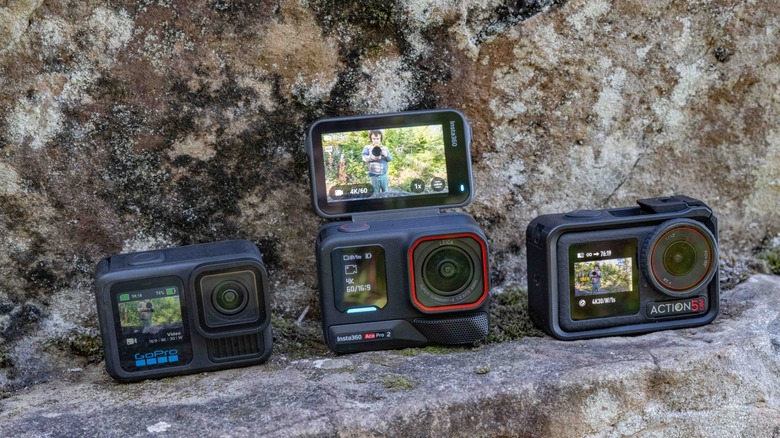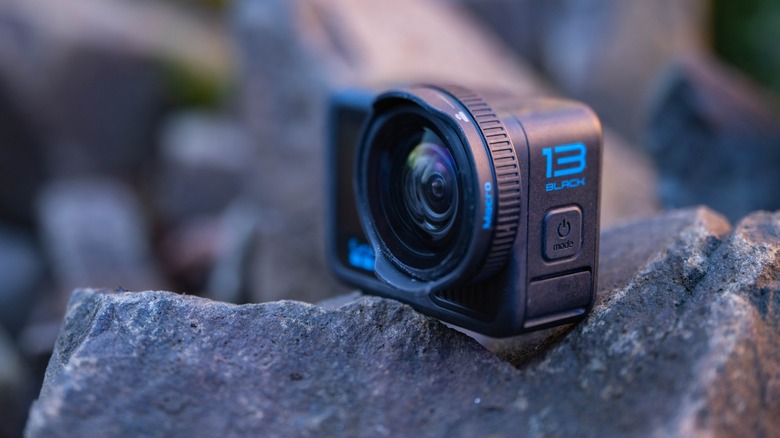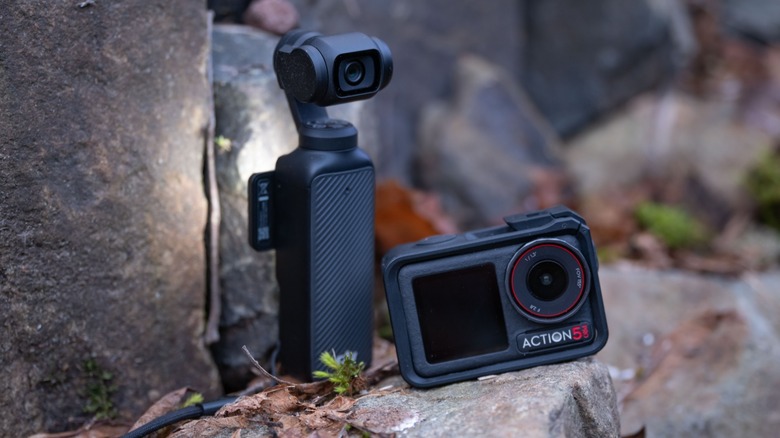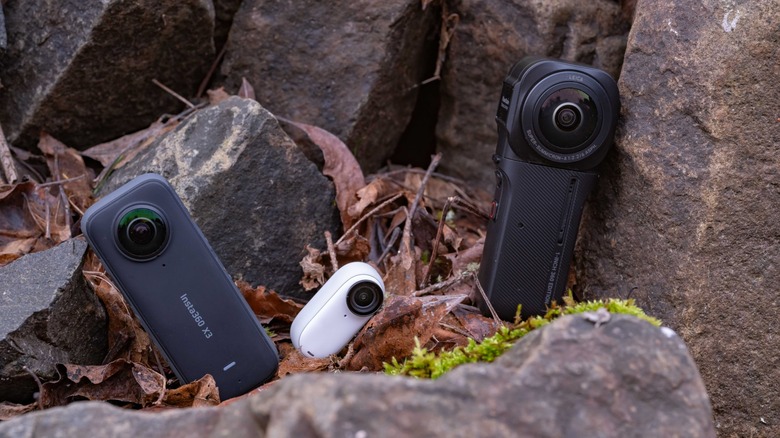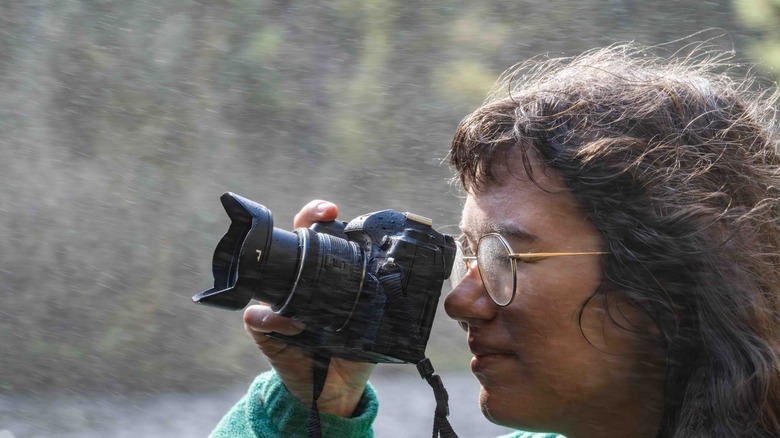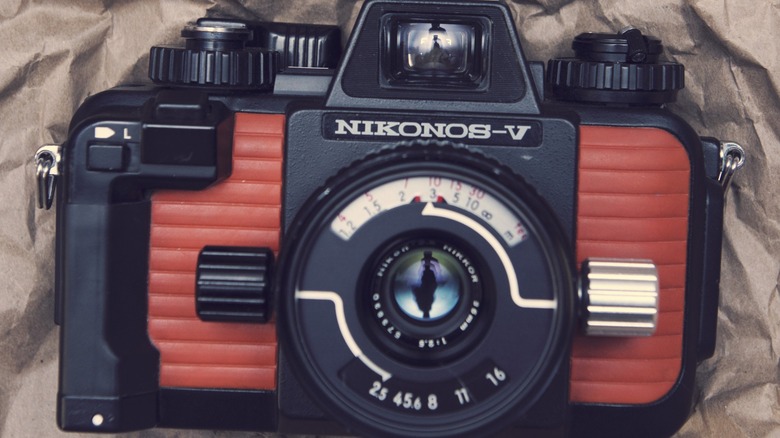8 Of The Best Action Cameras You Can Buy (And What Upgrades We Want To See) In 2025
We may receive a commission on purchases made from links.
If you want to record yourself doing something underwater, in the freezing cold of winter, or in a high-octane situation, then you'll want a camera that is capable of withstanding everything you can throw at it. Action cameras fill that roll, allowing you to capture high-quality video in the worst conditions.
Over the past few years, the action camera genre has become increasingly competitive. Once upon a time, GoPro was the only name that mattered in the space, but while manufacturers such as Sony, Garmin, and Nikon dropped out of the competition years ago, new challengers have arisen. The race between GoPro, DJI, and Insta360 is now practically too close to call, and creators are spoiled for choice; the very definition of what counts as an action camera has blurred.
The action camera you choose is now more a question of which suits your particular requirements the best rather than simply ranking these products from best to worst.
GoPro Hero 13 Black
GoPro still offers some advantages over its competitors despite falling behind in overall image quality. Its mounting system is far superior to DJI and Insta360, and the new lens system offers exciting versatility.
Rather than limit itself to utilizing adapters via a proprietary magnetic mounting system such as DJI and Insta360 seem to favor, GoPro instead have only increased the range of mounting options in their flagship camera. The Hero 13 Black offers the same folding prong mount and ¼-20 screw mount of the Hero 12 Black, but has now also included a magnetic mount option. That magnetic mount may be proprietary, but unlike DJI and Insta360, GoPro has retained other mounting options. This might seem like a small detail, but such built-in compatibility can sometimes make all the difference when you're out in the field.
The real sticking point with the Hero 13 Black is image quality, where it's painfully clear that its aging sensor technology has fallen behind the competition. However, it does make up for that to some degree by integrating electronic communication between the camera and a range of newly available lens mods, including a macro lens and an upcoming anamorphic lens that could be a genuine gamechanger. There's also the particular look of GoPro color science to be considered, which can be desirable. Overall, the Hero 13 Black remains a solid option.
Insta360 Ace Pro 2
The most recent camera from Insta360 is arguably the best action camera currently available and features one of the best touchscreen menu systems available in any camera. This makes the Ace Pro 2 one of the most enjoyable action cameras to use, particularly if you find yourself frequently swapping between modes and dialing in settings.
Of course, image quality is where the Ace Pro 2 shines, being arguably the best action camera in this regard due to its 1/1.3-inch sensor that can film at up to a whopping 8K 60fps resolution. It can also shoot in 4K at up to 60fps with HDR, which delivers footage without blown out highlights or crushed shadows. You may still run into circumstances where this HDR doesn't deliver the best-looking results or where you just don't want the look of HDR, and unlike the original Ace Pro, the Ace Pro 2 allows you to disable HDR recording entirely.
With fantastic low-light performance and a beefy integrated windscreen for its microphone, there's a lot to love about the Ace Pro 2. The articulating display really helps it stand out and makes it a great option if you want to monitor your footage while filming at low angles.
DJI Osmo Action 5 Pro
Going head-to-head with the Ace Pro 2, the DJI Osmo Action 5 Pro features particularly accurate color rendition and really fantastic battery performance while recording timelapse video. This is the only action camera which you can leave out to capture a timelapse practically overnight, the only downside here being that, unlike the Ace Pro 2 and Hero 13 Black, the Osmo Action 5 Pro still doesn't have a star trails mode, so you don't get that particular effect in-camera.
Low light performance and overall image quality are truly excellent here, with the natural look of the Osmo Action 5 Pro being particularly desirable. Unlike GoPro, which has a very distinct look, and Insta360, which tends to have what might be described as an exaggerated appearance, DJI has really dialed in the realism. Thanks to the included camera cage, the DJI Osmo Action 5 Pro is also perhaps the most rugged, and it seamlessly pairs with the DJI Mic 2, which makes it an exceptional camera for vlogging.
Insta360 Go 3
The Insta360 Go 3 is a miniature action camera intended for applications where a larger action camera is too bulky. The base model is limited in terms of resolution, but the upgraded Go 3S model offers 4K recording capability.
The Go 3 and Go 3S both feature minuscule camera capsules, which are completely sealed and waterproof. While a typical action camera may be quite compact, they seem massive in comparison to the camera module of the Go 3. This is a size of action camera that you can comfortably clip to your coat or hat or just magnetically slap onto any ferrous surface. The Go 3 (and its more powerful 3S variant) are ideal cameras for use with drones, as they add minimal weight and bulk while delivering excellent electronic image stabilization.
In addition to the camera module, the Go 3 comes equipped with a charging case which boosts the relatively short battery life of the camera module, as well as provides an articulating touchscreen and controls for changing settings. When clipped into this case, the Go 3 effectively becomes a standard action camera.
DJI Pocket 3
Though not rugged or waterproof, the DJI Pocket 3 is nonetheless capable of many of the tasks to which action cameras are typically assigned. Thanks to its 1-inch sensor, gimbal stabilization, and autofocus, the Pocket 3 offers vastly superior video quality to a more typical action camera. In fact, the Pocket 3 is in many cases a preferable option to using a high-end full-frame mirrorless camera such as the Nikon Z8 or Canon Eos R5 Mark ii purely due to its compact form factor and gimbal stabilization.
The Pocket 3 is great for everything from recording B-roll and vlogs while traveling, to filming in a studio setting or functioning as a super high-quality webcam. The built-in mic is surprisingly good, and like the Osmo Action 5 Pro it can connect wirelessly to the DJI Mic 2. So long as you don't plan on getting it wet, it's one of the most versatile cameras ever made.
Insta360 X4
While technically a 360 camera and not something in the style of a GoPro, the X4 can function just as well as an action camera while also providing the incredible creative flexibility of a 360 camera. In single lens mode, the Insta360 X4 produces ready-made 16:9 format footage just as any other action camera. However, if you capture footage using its full 8K 360 mode, you are granted the freedom after the fact to create all kinds of mind-bending effects at high resolution, and it ensures that you never miss a shot because your camera was pointed in the wrong way.
The Insta360 X4 is fully waterproof and built to take a hit, though if you plan to use it to record underwater you will need a housing to get good results, and in any situation where it might get knocked around you will definitely want to utilize the included lens protectors. The Insta360 X4 may not do the job of action cameras as well as purpose-made devices such as the Ace Pro 2, Hero 13, or Action 5 Pro, but if you want to capture 360 footage, it's also perfectly capable of being an action camera.
OM System Tough TG-7
The TG-7 is the compact camera to go for if you're looking for an action camera that's more tuned for photography, though it also records great video as well (see above for a sample captured with the TG-6). While the TG-7 may not be a huge step up over the TG-6, it's nonetheless the best tough, underwater-capable photography-focused camera you can buy.
Rather than the fixed focal length and fixed focus of typical action cameras, the Tough TG-7 features a 25-millimeter to 100-millimeter equivalent zoom lens and autofocus. Moreover, it's capable of focusing as close as 0.1 meters away from its subject, and with a macro ring light attachment, you will find this to be an extremely capable camera for capturing photos and video of tiny subjects. Just keep in mind that if you do plan to purchase this instead of a traditional action camera, the TG-7 does not have the advanced electronic stabilization of something like the Hero 13 Black.
OM System OM-1 Mk II
While this stretches the definition of an "action camera," the Om-1 Mk II is the most water-resistant, rugged and compact of all the large-sensor interchangeable lens cameras. Paired with the right lens this camera can take anything you can throw at it short of actual underwater photography.
The M.ZUIKO ED 12-45mm F4.0 PRO is a great weathersealed option, while if advanced weather sealing isn't so important to you, the M.ZUIKO DIGITAL ED 9-18MM F4.0-5.6 II is a more portable option. Unlike other cameras previously mentioned, the OM-1 Mk II can even do wildlife photography if you pick up a lens such as the M.ZUIKO DIGITAL ED 150-600MM F5.0-6.3 IS. Its autofocus system is on par with the best flagship full-frame camera from Nikon, Canon, and Sony, yet it's so compact that with a small enough lens, it won't add much weight or bulk to your bag.
The M4/3 sensor is really the star of the show though and it makes a world of difference compared to 1-inch and smaller sensors. It also has arguably the best image stabilization system in any interchangeable lens camera. It's not GoPro smooth, but it's still really impressive. The Om-1 Mk II is the camera for professionals who need to maximize image quality in extremely challenging situations.
What we want to see from GoPro in 2025
GoPro has its anamorphic lens mod coming later this year, which could be a gamechanger for the Hero 13. This will get you that sweet horizontal lens flare, 21:9 de-squeezed aspect ratio, and other anamorphic goodness that grants your footage a cinematic look. At $103.99, it's certainly a lot more affordable than a Viltrox EPIC lens. No other action camera offers the capability to shoot anamorphic video.
We also hope to see the GoPro Hero Max 2 make an appearance in 2025. The original Max was quite popular, but it was launched way back in 2019, so it's long overdue for a sequel. Of course, there's also the likely launch of the Hero 14 in autumn. GoPro really needs to implement an aggressive sensor upgrade in the Hero 14, and expanding their lineup of lens mods could also boost the value of the system.
The Trick for GoPro with the Hero 14 is going to be balancing the clear need for a larger sensor, with maintaining compatibility with existing lens mods. GoPro will likely focus on upgrading sensor tech rather than size, and this could mean a serious boost to image quality. We want to see GoPro expand its range of available lens mods still further. For example, a super telephoto lens might have some cool applications, or a tilting lens enabling you to capture a miniature effect. Ultimately though, GoPro does need a camera with a larger sensor, so perhaps they should make something like a "GoPro Hero Titan" with an M4/3 sensor and autofocus.
What we want to see from DJI in 2025
There is also the prospect of the Osmo Action 6 Pro to look forward to in the fall, and we want to see that camera finally implement a one-inch sensor. There are challenges with the extra bulk this necessarily adds to the camera, but ultimately, the advantages of moving from 1/1.3 inches to a single inch outweigh the downsides of a larger lens bump. Additionally, we'd like for DJI to implement autofocus in their action camera, which would make it more versatile in certain applications. If DJI could stick the Pocket 3 camera into an Osmo Action camera and use a wider lens, that would be amazing. It would also be nice if DJI could find a way to integrate a ¼-20 screw mount into the Osmo Action 6 Pro.
It's also possible we may see a DJI Pocket 4 this year, though perhaps we might have to wait until 2026. Regardless, the main upgrade we want to see here is some degree of water and dust resistance. What would be really exciting, however, would be a "DJI Pocket Pro", which would be a larger version of the camera utilizing a camera such as that seen on the DJI Mavic 3 Pro with a M4/3 sensor, alongside several secondary cameras. It would, by necessity, be much larger than the Pocket 3, perhaps not exactly pocket-sized, but it could still be fairly compact. A few other upgrades such a theoretical camera could provide would be a removable battery, an upgraded microphone, and a more durable display.
What we want to see from Insta360 in 2025
We aren't likely to see an Insta360 X5 in 2025, but it would be great to see a new version of the Insta360 One RS 1-inch 360. That camera provided a much larger image sensor than most consumer 360 cameras, and it was able to provide much better low-light quality because of it. With the Insta360 X4 offering 8K recording from its ½-inch sensor, it would be great to see 8K (or better) resolution in a 360 camera with a 1-inch sensor.
As with DJI and GoPro, there will likely be an Insta360 Ace Pro 3 in fall, and my suggestions for possible upgrades from this camera are pretty much exactly what we're asking for from the DJI Osmo Action 6 Pro — a one-inch sensor and possibly autofocus, along with an integrated ¼-20 screw mount are key improvements which would really elevate the next generation of action cameras. As for a potential Insta360 Go 4, we would most like for the charging case to be as waterproof as the camera module.
What we want to see from OM Systems in 2025
It's hard to say what OM Systems might have up its sleeves, but what we'd really like to see is a pro version of the Tough series cameras with a M4/3 sensor and a compact wide-angle prime lens. A fully waterproof, dive-safe-out-of-the-box camera with a larger sensor is something that just doesn't exist on the market right now, and OM Systems is perfectly positioned to fill this void. In addition to the upgraded sensor and lens, we'd like to see more robust controls with improved operability while wearing gloves.
Since this would obviously be an expensive, high-end camera, there's still plenty of room for a Tough TG-8, which could offer a greater leap forward compared to previous generations of these cameras. OM Systems should go bigger here, too, with a one-inch sensor, while retaining the macro-focusing capability of its predecessors. More powerful onboard lighting would also be welcome, as would the aforementioned upgrades to the control scheme.
The waterproof camera we wish Nikon bring back
Nikon once manufactured a line of interchangeable lens film cameras branded as Nikonos, which were fully waterproof and designed for use underwater by divers. It would be amazing if Nikon was to bring Nikonos back, if not as an interchangeable lens system then as a fixed lens fully waterproof rugged camera with a full-frame sensor. This is similar in concept to the "OM Systems Tough Pro" camera pitched above, but of an even higher caliber.
This "Nikonos Z" would be designed not just for underwater photography, but for all manner of rugged, hazardous conditions. Unlike the camera we pitched for OM Systems to make, this Nikon would not be created with compact size or light weight as a priority. Given the range of potential use cases, we would suggest a 16-50mm zoom range with an f/2.8 aperture. On a full frame sensor with a dive-worthy construction, that would make this a chunky camera indeed, but many people might find the high cost, weight, and size to be worthy tradeoffs.
Should you buy an action camera now or wait till fall?
While the next generation of action cameras will undoubtedly offer attractive upgrades, the currently available lineup from various manufacturers is replete with extremely capable options. Larger sensors and autofocus may seem to be the logical next step for Insta360, GoPro, and DJI, but such speculation cannot be counted on. If you need a new camera for an upcoming project or vacation, you shouldn't feel compelled to hesitate on this generation.
As to which action camera you should buy, that's a personal decision you should make based on which one best suits your needs. Out of the cameras discussed here, there's not really a best and worst, and it would indeed be a difficult task to rank them with any confidence. It's certainly great to have so many excellent options, proving that fierce competition between brands is always a good thing for consumers.
